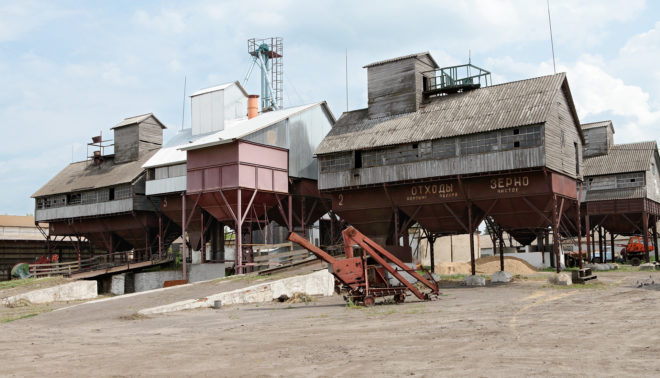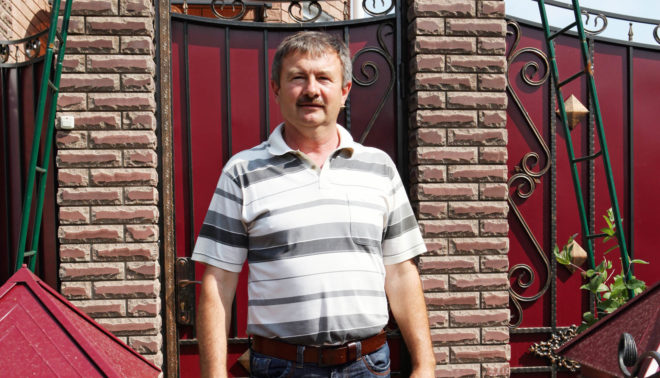The scent of honey wafts in the air. This is no surprise, as we’re standing in the middle of a flowering white buckwheat field with the blossom emitting this intense aroma. Bees, enticed here by the scent and the nectar secreted by the plants, visit them during the long flowering phase from July to September. Nature was clever to do this, as common buckwheat (Fagopyrum esculentum) is reliant on cross-fertilisation by insects.

Arable farmer Vladimir Ivanovich Shashkov annually grows 500ha (1,200ac) of buckwheat.
The field that seems to stretch to the horizon belongs to Vladimir Ivanovich Shashkov. Of course, the area is not quite that big. His largest field measures a whole 280ha, though the average size is “only” 140ha (345ac). Overall, the Russian cultivates an area of approximately 3,400ha (8,400ac), yet this makes him one of the smaller agricultural businesses, not including self-sufficient farmers. Those who want to belong to the large businesses need to have hectares in five or six-digit figures. Europeans should not be too impressed by this either, since the colossal Russia, spanning 6.5m mi2, is about as large as Europe and the USA together.
Crop rotation and fallowing
Every year, farmer Shashkov grows approximately 500ha (1,200ac) of buckwheat. This makes him one of the larger producers of this modest fruit seed. Here in the area around Borilova, a small town near Oryol, around 220mi south of Moscow, wheat is the dominant crop.
We are trying to cultivate varieties that will become more tolerant to cold.
Vladimir Ivanovičh Šašhkov
Why is he growing this thermophilic crop? “It suits my crop rotation, which is made up of wheat, buckwheat, rye, rapeseed and fallow fields,” said Shashkov. Ultimately, buckwheat is not a grain but like rhubarb, it belongs to the knotweed family. The name of the plant and its brown triangular fruit comes from its similarity to beechnuts. An advantage for the crop farmer is the late sowing, from mid to the end of May, as this fits in well with his work schedule. This is because buckwheat is very sensitive to the cold and cannot tolerate frost. The fruit seed only begins to germinate and grow at 8 degrees C, but then it happens quickly. “In the meantime we are trying to cultivate varieties that will become more tolerant to cold,” he said.
Although “the queen of soils”, or chernozem, is right under our feet, our conversation does not then turn to record harvests, but instead the opposite. Why are fallow fields in his crop rotation? Is it not really a sin to leave such soil fallow? “I don’t just have chernozem, I also have sandy and loamy areas. However, the decisive factor is that without a varied crop rotation, including fallow fields, I cannot farm crops on a long-term basis. The soil has to withstand extreme temperature fluctuations here from +30 degrees C in the summer and -30 degrees C in the winter,” replied Shashkov. Fallow chernozem fields are common throughout Russia, usually on a three-yearly cereal crop cycle.
From the field to the kitchen
Buckwheat is not only a favourite in the field, but also in Russian cuisine. On average, each Russian consumes 5kg of it a year, according to a report from the Moscow Times. A common staple food, “gretchka” as it is called in Russian, features in the morning as groats or porridge for breakfast. It can also be a side dish for meat and fish during the day and a stand-alone dish with mushrooms or made into a pancake.

Buckwheat is an important part of Russian cuisine, usually cooked for eating. The flour is mainly used for making pancakes.
The common feature in all recipes is that the seeds are used only in their husked form. From a nutritional and physiological perspective, buckwheat is also attractive as it contains a lot of starch, high-value protein, vitamin B and various trace elements. As it is gluten free, the plant is also a suitable food for people with an intolerance or allergy.
Use as a cleaning crop
Nikolay Eugenyevich Matyushenko is another farmer who regularly grows buckwheat. He lives with his wife in the Korenevsky District, which is part of the Kursk administrative region. His children are grown up and do not work in farming. However, the farmer hopes that one day they will join him in the 2,000ha (5,000ac) farm business. Like other farmers, Matyushenko does not live on the farm, but a few kilometres away from it.

A privately-run agricultural business does not automatically have a complete farmstead – its more a kind of parking space with older farm-buildings.
Unlike in Europe, a privately-run agricultural business does not automatically have a complete farmstead with a house, buildings and machinery shed. In Russia there is more likely to be a kind of parking space with older farm buildings that are generally used as a place for storing machines and a workshop. There is also always housing for employees and often silos for storing the grain after the harvested.

Nikolay Eugenyevich Matyushenko does not live on his farm but a few kilometers away in the nearest village.
Speaking of staff, is it hard to find employees in such a rural area? “I have 18 members of staff and everything is going well at the moment. However, there have been times where people have come and gone – either of their own accord or because they had to,” the trained agronomist remembered, who seized the opportunity to become self-employed at the end of the Soviet Union. As he had previously had a leadership role in a “kolkhoz”, a collective farm, he did not find it too difficult to manage a farm. Yet it took several years before he was proud to be a self-employed farmer, which he openly admits. The reason for this being that farming does not have the best image, particularly with young people. They move to towns after they finish school to find work.
But let’s return to buckwheat. What are his motivations for growing it? “It is a genuine cleaning crop,” said Matyushenko. Because of the crop’s quick growth, it suppresses weeds and also combats sugar beet nematodes. Both of these attributes suit Matyushenko’s crop rotation perfectly which, in addition to sugar beet, also includes wheat, barley, soya, maize, sunflowers and lupines.
Tough harvesting deadlines
Once again, the air smells like honey. This time we are standing with Viktor Nikolayevich Petrov on one of his buckwheat fields. The farmer explains that there’s no way to dismiss this annual crop if you carry out crop rotation seriously. Because the crop has neither specific requirements from the soil nor the fertilisation, and it is well self-tolerating.
In contrast, things are somewhat more complicated for harvests that may be ready at the end of August, depending on when it was sown. As the plant can grow new flowers and leaves right to the end without interruption, it is not easy to ascertain the best harvest date. As a rule, harvesting can be done when around 80% of the seeds are ripe. In practice, farmers use conventional combine harvester techniques for grains.
Alternatively, they first cut the buckwheat and then lay it on windrows in order to perform the collection and threshing later on with a pick-up attachment. Viktor Nikolayevich Petrov considers that every year is different and each harvest is a new experience: “Buckwheat is like women. One lifetime is not enough to understand this plant.”

In contrast, things are somewhat more complicated for harvests that may be ready at the end of August, depending on when it was sown. As the plant can grow new flowers and leaves right to the end without interruption, it is not easy to ascertain the best harvest date. As a rule, harvesting can be done when around 80% of the seeds are ripe. In practice, farmers use conventional combine harvester techniques for grains.
Buckwheat is like women. One lifetime is not enough to understand this plant.
Viktor Nikolajevich Petrov
Alternatively, they first cut the buckwheat and then lay it on windrows in order to perform the collection and threshing later on with a pick-up attachment. Viktor Nikolayevich Petrov considers that every year is different and each harvest is a new experience: “Buckwheat is like women. One lifetime is not enough to understand this plant.”







